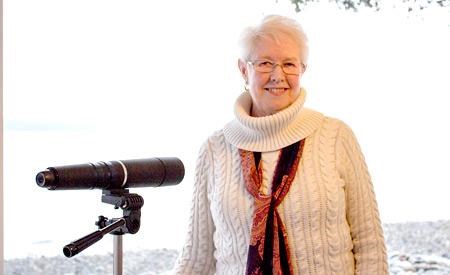After more than a decade, Karen Southern is set to launch the first of a three-volume series on the history of Townsite.
The first book, House Histories and Heritage, Vol 1—The Vanishing Buildings, A Visual History of the Historic Powell River Company Townsite, will be launched at the author meet and greet book signing starting at 7 pm on Thursday, December 19, at Breakwater Books and Coffee.
The publishing initiative, more than 10 years in the making, was produced by the Townsite Heritage Society* and will comprise more than 900 pages to be compiled in three volumes when complete.
A life-long native of Powell River, Karen’s first job was at the Patricia Theatre. “I worked there from 1959 to 1961,” she said. “I was 16 when I started. From there I secured a job at MacMillan Bloedel, then, much later, I became an archivist and coordinator at the Powell River Historical Museum for several years.”
It was in 1975 that Southern started her writing career. “I liked short stories because there was an end in sight,” Southern said of her early writing days, although everything she has produced since then has been book length non-fiction.
“In 1991 the BC Heritage Trust came to take a look at Townsite and decided it was an ideal community to preserve,” she said. “I was the coordinator at the museum at the time and they were thrilled that we had so many good photos of the old community in the museum archives.”
In the early days the town was inspired by an approach developed around the concept of equitable housing for company employees. Founders Dwight and Anson Brooks and MJ Scanlon were revolutionary in this regard and came up with the idea in answer to the squalor and destitution that seemed to plague other company townships. “You can see the same type of architecture and look of the community in the Shaughnessy and South Granville districts in Vancouver,” Southern said. “The architecture there emulated the arts and crafts movement that was big through the early 1900s.”
Townsite was designated a National Historic District of Canada in 1995, is one of only seven in the country and the only such designation in western Canada.
In 2001, Southern applied for a grant to produce the book project in cooperation with Townsite Heritage Society, but it was soon evident that three books would be needed to tell the story when all was said and done.
“Evan Sadler, Curly Woodward and Frank Haslam were old-timers who helped out a lot with the book,” said Southern. “They remembered many details about the community, who lived where and where things happened.”
Despite the fact the project has taken so long, there were epiphany moments along the way that kept her going. When she discovered the 1911 census—the first of its kind to be published—Southern realized that she had access to an invaluable source of information on the Townsite houses and to the historic Bon Ton apartments.
“Ken McMillan gave me his grandmother’s diary, which confirmed that the Cedar Street houses weren’t in fact complete until 1916,” a point of contention between Woodward and Sadler. Haslam pointed out who lived where.
“There was a house at the corner of Sycamore and Ash streets that gave me quite a challenge,” she said. “We didn’t have a picture of it before the place was actually physically moved to Cedar Street until one day Ron Bennett came for coffee and brought a postcard along with him.” A photo of the house as it looked at the corner of Sycamore and Ash before it was moved was on the postcard, solving the mystery that it was still at that location in 1912.
Woodward put his job on the line to preserve history. He worked for MacMillan Bloedel and one day found out the company had intended to toss out four or five old ledgers dating from 1912 to 1915 or 1916. The company told him hands off. When the company refused to let him keep them, he stashed the ledgers atop one of the old light fixtures in the office and grabbed them later.
*Editor's Note: This information was corrected from the original story.



